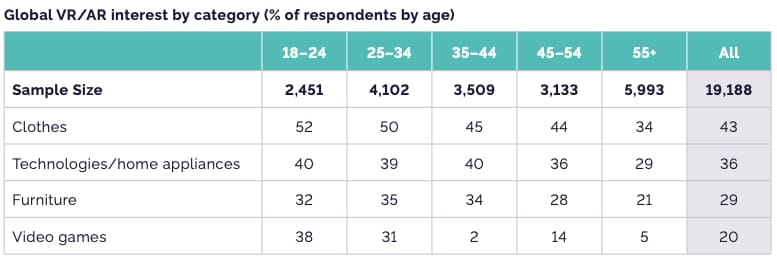
AR’s role as a shopping utility — a.k.a., camera commerce — continues to be validated. That includes its ability to boost conversion rates and reduce product returns. And it takes on new meaning in the Covid era when the value of visualizing products remotely in 3D is amplified.
This value flows from AR’s ability to combine eCommerce benefits (pricing, endless aisles, etc.) with physical retail benefits that have been taken away (product perspective, etc.). And in the post-Covid era, AR could likewise have utility in powering in-aisle interactions and touchless browsing.
As we examined recently, the technology is still in early adopter phases but is gradually assimilating among mainstream audiences. And like past shopping technologies such as high-end photography, the tipping point could eventually come when it shifts from acclimation to expectation.
But where are we in that journey? Though there are several positive signals for AR shopping – and we’re often bullish on its potential – how do real consumers feel about it? Are they asking for AR? A recent YouGov poll sought to answer this question – the focus of this week’s Data Dive.
Data Dive
Diving right in, what did the YouGov study uncover? Surveying more than 19,000 individuals in all age ranges across 17 international markets, it uncovered the following AR shopping sentiments.
– On average, 32 percent of consumers expressed interest in using AR in the shopping flow to visualize and inform product purchases*.
– Breaking this down by product, interest in AR for clothes shopping led the way (43 percent), followed by tech & home appliances (36 percent), furniture (29 percent) and video games (20 percent).
– Editorial side note: we’re not sure how AR would add value or context to the consideration cycle of video game purchases, which is likely why it scored so low.
– As a thought exercise, if we were to eliminate video games from the results, the average AR interest for the remaining hard-goods categories grows to 36 percent.
– Breaking down results by age, it’s a mixed bag. If we zero in on clothing, the leading age group showing interest in AR shopping is 18-24 (52 percent), followed by 25-34 (50 percent), 35-44 (44 percent) and 55+ (34 percent).
– This indicates a clear correlation between AR interest and age, though it’s an inverse relationship where interest wanes as age increases.
– Breaking down results by geography – and sticking with clothing as a product category – the most interest lies in Mexico (60 percent), followed by UAE (53 percent), Asia/Pacific (50 percent), Europe (41 percent), and U.S. (27 percent).
*The exact survey-question wording for all of the above was “Thinking of the clothes/goods you might buy in the next 12 months, which of the following categories would you be interested in trying via augmented reality/virtual reality before making a purchase?”

Good News and Bad
These results are a double-edged sword. Though sentiments toward AR shopping — 32 percent interest on average — aren’t as great as glowing editorials often suggest, they hold a few key insights. And the good news is that AR shopping has ample headroom to grow.
Among strategic takeaways, it’s clear that AR shopping is far from mainstream. This signals that the technology is still young and unproven. Therefore, the most successful strategies will meet users halfway by not making them have to work for it. AR needs to be laid in their direct paths.
What does that mean? There should be minimal “activation energy” to launch AR experiences. This bodes well for web AR, as it can be launched quickly from most smartphones as opposed to app downloads. AR activation needs to be dynamic in places like store aisles.
For the same reason, QR codes on product packaging, store signage, and websites can prompt AR activations. This can be a much-needed nudge or reminder that AR is there, as it piggybacks on a familiar format. Furthermore, it lets brands and retailers enliven their static media.
Based on YouGov’s results, all of the above tactics have greater urgency among older consumers. This stands to reason as the Snapchat generation needs less of a push to try AR. Fortunately, that bodes well for AR’s longevity as today’s younger consumers phase into the majority.

